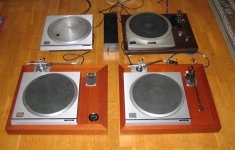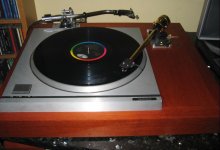One more once
O.K., the pictures of the plinth I built for my friend Albert Porter are now up on this website:
http://www.soundfountain.com/amb/sp10plinth.html
It can also be seen here:
http://cgim.audiogon.com/i/vs/i/f/1193606055.jpg
A very interesting project with a surprisingly good result.
John
O.K., the pictures of the plinth I built for my friend Albert Porter are now up on this website:
http://www.soundfountain.com/amb/sp10plinth.html
It can also be seen here:
http://cgim.audiogon.com/i/vs/i/f/1193606055.jpg
A very interesting project with a surprisingly good result.
John
Thanks! The salient feature of that plinth is the grey cast iron block which is coupled by a brass rod to the bottom bearing of the motor and acts as vibration sink. The result was an amazingly quiet turntable - actually more quiet and with blacker backgrounds than the Walker Proscineum. Not at all what we expected.
John
John
jlsem said:Thanks! The salient feature of that plinth is the grey cast iron block which is coupled by a brass rod to the bottom bearing of the motor and acts as vibration sink.
John
Would you elaborate somemore on this one??
Any electric motor produces some noise, and a direct drive turntable motor is coupled directly to the platter and is not isolated from the rest of the 'table. The moving coil cartridges used have outputs on the order of 200-600 microvolts, so noise is obviously an issue. The grey cast iron block has a very high specific damping factor (highest among commonly available materials) and the brass rod makes a convenient transfer path for noise and vibration to the iron block, where they magically disappear. This base is admittingly a brute-force solution to the problem, but it worked very well.
John
John
jlsem said:Any electric motor produces some noise, and a direct drive turntable motor is coupled directly to the platter and is not isolated from the rest of the 'table. The moving coil cartridges used have outputs on the order of 200-600 microvolts, so noise is obviously an issue. The grey cast iron block has a very high specific damping factor (highest among commonly available materials) and the brass rod makes a convenient transfer path for noise and vibration to the iron block, where they magically disappear. This base is admittingly a brute-force solution to the problem, but it worked very well.
John
What noise? What problem?
"What HiFi" + other reviewers did measurements of niose/rumble++, and found it better than most high-end belt-drives (of it's time)...
Arne K
Exactly how did you couple the brass rod to the motor/spindle?
I had an idea for something similar for a lenco. Fix a spring metal bracket to the motor and then hang a weight off that to one side - like a tunable vibration damper that you sometimes see on larger machines. It sets up a vibration thats exactly the opposite of whatever is feeding into it and hence cancelling it out. The energy is dissipated as kinetic.
Fran
I had an idea for something similar for a lenco. Fix a spring metal bracket to the motor and then hang a weight off that to one side - like a tunable vibration damper that you sometimes see on larger machines. It sets up a vibration thats exactly the opposite of whatever is feeding into it and hence cancelling it out. The energy is dissipated as kinetic.
Fran
I've done a similar trick on my Garrard 301. I clamp the bottom of the platter bearing firmly to the underside of the (solid) plinth. It made a big improvement to the tightness of the bass. When I saw that the SP10 had only a rubber cover to prevent a similar trick being applied to their bearing I immediately wondered if their designers weren't decades ahead of me.
Exactly how did you couple the brass rod to the motor/spindle?
The rubber seal described by EC8010 was carefully cut away from the bottom bearing and the threaded brass rod seen in the pictures was run up through the iron block until it touched the bearing with firm pressure and then locked into place with an eccentric cam. The brass rod where it contacts the bearing is polished with a large radius.
What noise? What problem? "What HiFi"
Unless "What HiFi" measured zero rumble and noise from the SP-10 I'm inclined to believe this plinth represents an improvement. Remember that we were comparing it very favorably to the Walker Proscineum which is a highly regarded TT at this time.
As a side note, installing this set-up on an isolation platform killed every gain made by the plinth alone.
John
P.S. There appears to be some skepticism among Norwegians.
I had an idea for something similar for a lenco. Fix a spring metal bracket to the motor and then hang a weight off that to one side - like a tunable vibration damper that you sometimes see on larger machines. It sets up a vibration thats exactly the opposite of whatever is feeding into it and hence cancelling it out. The energy is dissipated as kinetic.
That method would of course be limited to a single vibrational frequency whereas the iron block used here takes advantage of the internal vibration damping property of cast iron, which is exceptional and covers a wide frequency spectrum. I don't have any calculated or experimental data to share since this was mostly a casual experiment using a brute force method. I am sure that such a system could be optimized.
John
jlsem said:
--
Unless "What HiFi" measured zero rumble and noise from the SP-10 I'm inclined to believe this plinth represents an improvement. Remember that we were comparing it very favorably to the Walker Proscineum which is a highly regarded TT at this time.
As a side note, installing this set-up on an isolation platform killed every gain made by the plinth alone.
John
P.S. There appears to be some skepticism among Norwegians.
Not skeptic, the work looks beautiful! (maybe a little envious)
(Beeing a DD fanatic myself)
I remember a line from test; below measurable limits, test only showed surface noice from test-disc...
Arne K
Attachments
Wow! Nice collection! After hearing the results of our experiment, I'm considering DD myself. I've always been a Micro Seiki freak and I can see by your tonearms that you like Micro as well. Now I'm envious!
My Micro Bl-51 is here, pictures 22 and 23:
http://www.triodeandco.us/lonestar07/photos/index.html
John
My Micro Bl-51 is here, pictures 22 and 23:
http://www.triodeandco.us/lonestar07/photos/index.html
John
Have had a RX1500, only kept the 505 arm, and got another 505MkIII for the other tt.
Great arms, can still be found for reasoable prices!
Main-arm(s) are AudiOrogami PU-7, 11" long. Superb custom handwork!
http://www.audioorigami.co.uk/
Arne K
Attachments
- Status
- This old topic is closed. If you want to reopen this topic, contact a moderator using the "Report Post" button.
- Home
- Source & Line
- Analogue Source
- Layered plinth for SP-10


